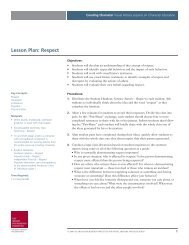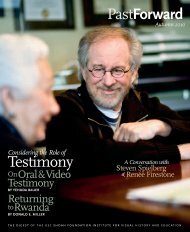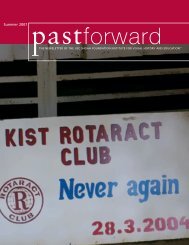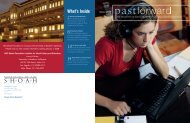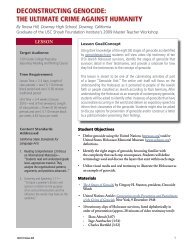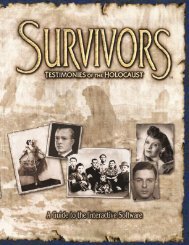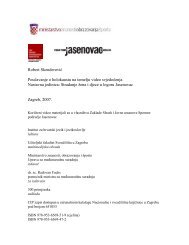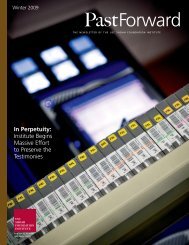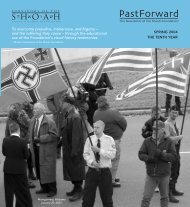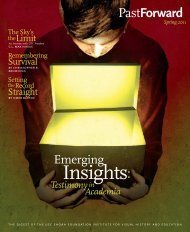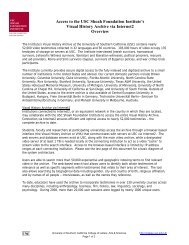Download the Volevo solo vivere press kit - USC Shoah Foundation ...
Download the Volevo solo vivere press kit - USC Shoah Foundation ...
Download the Volevo solo vivere press kit - USC Shoah Foundation ...
Create successful ePaper yourself
Turn your PDF publications into a flip-book with our unique Google optimized e-Paper software.
poster1
I ONLY WANTED TO LIVE(VOLEVO SOLO VIVERE)Press KitTable of ContentsPOSTER ........................................................................................................................................................................1TABLE OF CONTENTS ..............................................................................................................................................2TO CONTACT US ABOUT THE FILM......................................................................................................................3TECHNICAL INFORMATION....................................................................................................................................4SYNOPSIS ....................................................................................................................................................................5RECENT NEWS ...........................................................................................................................................................5BIOGRAPHICAL NOTES ON THE SURVIVORS FEATURED IN THE FILM.......................................................6THE <strong>USC</strong> SHOAH FOUNDATION INSTITUTE IN ITALY .....................................................................................8MIMMO CALOPRESTI ...............................................................................................................................................9VARIETY @ THE CANNES FILM FESTIVAL .......................................................................................................11SCREEN......................................................................................................................................................................13LA REPUBBLICA (PREMIER DAILY ITALIAN NEWSPAPER)...............................................................................15LIBERAZIONE (DAILY ITALIAN NEWSPAPER) .................................................................................................20IL FOGLIO (DAILY MILAN NEWSPAPER)...............................................................................................................23IL MESSAGGERO (DAILY ITALIAN NEWSPAPER)................................................................................................28L’UNITA (DAILY ITALIAN NEWSPAPER) ...............................................................................................................31PRIMISSIMA SCUOLA (ITALIAN TEACHING MAGAZINE)..................................................................................35CORRIERE DELLA SERA (DAILY ITALIAN NEWSPAPER)...................................................................................422
’out The FilmSteven Spielberg and <strong>the</strong> <strong>USC</strong> <strong>Shoah</strong> <strong>Foundation</strong> Institutefor Visual History and EducationpresentI ONLY WANTED TO LIVE(VOLEVO SOLO VIVERE)a documentary by Mimmo Caloprestiproduced byGagè Produzioni, Wildside Mediain co-production with Rai Cinema, ventura filmand RTSI-Televisione SvizzeraTO CONTACT US ABOUT THE FILMPRODUCER AND U.S.DISTRIBUTION:<strong>USC</strong> <strong>Shoah</strong> <strong>Foundation</strong> InstituteSonya Sharp, Public Outreach &MarketingLos Angeles Office Direct: 213.740.6034Los Angeles Office Main: 213.740.6001sonyas@college.usc.eduwww.college.usc.edu/vhiWORLD SALES:Films DistributionFrançois Yon, PartnerParis Office Direct: +33 6 03 49 65 00Paris Office Main: +33 1 53 10 33 99Fax : +33 1 53 10 33 98fry@filmsdistribution.comwww.filmsdistribution.com3
TECHNICAL INFORMATIONThe Testimonies collected in <strong>the</strong> film are those of:Andra BucciEsterina Calò Di VeroliNedo FianoLuciana Nissim MomiglianoLiliana SegreSettimia SpizzichinoGiuliana TedeschiShlomo VeneziaArminio WachsbergerTestimonies from <strong>the</strong> archive of <strong>the</strong> <strong>USC</strong> <strong>Shoah</strong> <strong>Foundation</strong>Institute for Visual History and EducationDirected byExecutive ProducerMimmo CaloprestiSteven SpielbergProduced by Mimmo Calopresti - Gagè Produzioni & Laurence Hoffmann -Wildside MediaFor <strong>the</strong> <strong>USC</strong> <strong>Shoah</strong> <strong>Foundation</strong> InstituteDouglas Greenberg, Executive DirectorKim Simon, Executive in Charge of ProductionMark Edwards, ProducerCo-produced byAssociate ProducerIn collaboration withEdited byOriginal ScorePost-productionRunning TimeRai Cinema, ventura film, RTSI – Swiss TelevisionFrancesca AlatriComune di RomaAmbassador Mel SemblerMassimo Fiocchi, Valerio QuintarelliFederico Badaloni, Rachel’sCinecittà Digital75 min.4
SYNOPSISNine Italian citizens survive deportation and internment in <strong>the</strong> Auschwitz death camps.Nine stories through which we follow <strong>the</strong> most significant events of this harrowingexperience: <strong>the</strong> enactment of <strong>the</strong> racial laws in Italy, <strong>the</strong> futile escape attempts, <strong>the</strong>deportation, <strong>the</strong> separation from o<strong>the</strong>r family members, <strong>the</strong> miraculous survival inAuschwitz, and liberation with <strong>the</strong> arrival of <strong>the</strong> allied soldiers.Words that we may not be hearing for <strong>the</strong> first time, but which narrate <strong>the</strong> many aspects of<strong>the</strong>se tragic accounts: from <strong>the</strong> most intimate and personal to <strong>the</strong> more well-known andcruel. These individuals, through <strong>the</strong>ir testimonies, are not afraid to reveal feelings oftenderness and compassion, as well as moments of happiness.Mimmo Calopresti made this film by viewing and selecting from <strong>the</strong> hundreds of Italiantestimonies collected in <strong>the</strong> archives of <strong>the</strong> <strong>USC</strong> <strong>Shoah</strong> <strong>Foundation</strong> Institute for VisualHistory and Education, as well as archival footage and photographs taken from <strong>the</strong> personalphoto albums of <strong>the</strong> survivors.NEWS• I Only Wanted To Live (<strong>Volevo</strong> <strong>solo</strong> <strong>vivere</strong>) premiered in Rome at a ceremony for <strong>the</strong>Day of Memory in January, 2006. Organized by <strong>the</strong> Comune di Roma’s office of <strong>the</strong>Mayor, <strong>the</strong> premiere was attended by approximately 1,000 guests including MayorVeltroni, students, members of <strong>the</strong> government, <strong>the</strong> local community, and friends. Thescreening was held at <strong>the</strong> Auditorium, Rome’s premier concert hall, designed by architectRenzo Piano and commissioned by Mayor Veltroni in 2000.• Since its premiere, <strong>the</strong> film has had a national broadcast in Italy, and a <strong>the</strong>atrical releasein Switzerland as well as five Italian cities: Rome, Florence, Turin, Milan, and Padova. Ithas also been released on DVD in Italy.• I Only Wanted To Live (<strong>Volevo</strong> <strong>solo</strong> <strong>vivere</strong>) was nominated for a 2006 Donatello Awardin <strong>the</strong> category of Best Feature Length Documentary. The Donatello Award is <strong>the</strong> mainnational film award in Italy. In addition, <strong>the</strong> film won <strong>the</strong> Golden Phoenix Grand Prizeat <strong>the</strong> Jewish Film Festival in Warsaw in 2007.• The film was chosen to screen (in <strong>the</strong> Official Selection, Out of Competition) at <strong>the</strong> 2006Cannes Film Festival. Since <strong>the</strong>n it has screened at <strong>the</strong> United Nations in New York andat film festivals internationally, including: Jerusalem; Montreal; Melbourne and Sydney;Boston; Palm Beach; Washington DC; Palm Springs; Atlanta; Los Angeles; Barcelona;Trinidad; and San Francisco.5
BIOGRAPHICAL NOTES ON THE SURVIVORS FEATURED IN THE FILMAndra (Alessandra) BucciBorn in Fiume on July 1 st , 1939, she was 4 years old when, with her grandmo<strong>the</strong>r, hermo<strong>the</strong>r, her sister, her cousins, and her aunt and uncle, she was arrested and deported to <strong>the</strong>Trieste concentration camp. She was later transferred to Auschwitz where she was liberatedin 1945 when she was 6 years old and believed that life in <strong>the</strong> death camp was “normal life”.Esterina Calò Di VeroliBorn in Rome in 1928, everyone called her «Persichella» (“little peach,” in Roman dialect)because of her rosy complexion. She was no more than a girl in 1944, when she was arrestedalong with her bro<strong>the</strong>r-in-law while she was visiting her sister who had just given birth. Shewas transported to Fossoli and <strong>the</strong>n to Auschwitz-Birkenau. She was part of <strong>the</strong> group ofprisoners who were forced to reach Bergen-Belsen in <strong>the</strong> infamous “Death march.” Among<strong>the</strong> few who survived this terrible journey, <strong>the</strong>re was a group of Roman girls, who met upagain and shared <strong>the</strong> last, terrible days in <strong>the</strong> camp. There, <strong>the</strong>y also met SettimiaSpizzichino and, after <strong>the</strong> liberation of <strong>the</strong> camp, on April 15 th , 1945, all of <strong>the</strong>m toge<strong>the</strong>rfinally managed to return to Rome with <strong>the</strong> help of a group of Italian prisoners of war whohad also been liberated.Nedo FianoBorn in Florence, he was 18 years old when he was arrested by Italians on February 6 th ,1944. He was imprisoned in <strong>the</strong> Florence prison, and from <strong>the</strong>re he was taken to <strong>the</strong> Fossolicamp. He was deported to Auschwitz on May 16 th , 1944, with <strong>the</strong> rest of his family, ofwhich he was <strong>the</strong> only survivor. He was liberated in March of <strong>the</strong> following year inBuchenwald, and today he is one of <strong>the</strong> most significant figures among <strong>the</strong> “witnesses ofmemory.” Milanese by adoption, he published <strong>the</strong> book “A 5405 The Courage To Live,” MontiEdizioni, Varese 2003. In it he writes: “The thing that has connoted my entire life was mydeportation to <strong>the</strong> Nazi death camps. My entire family ended up with me in Auschwitz, <strong>the</strong>ywere all exterminated. At eighteen I became an orphan and this experience, which was sodevastating, made me a different man, a witness for <strong>the</strong> rest of my life.”Luciana Momigliano NissimBorn in Torino on October 20 th , 1920, after September 8 th she escaped to Valle d’Aosta. Shewas friends with Primo Levi and Wanda Maestro, and with <strong>the</strong>m she decided to join <strong>the</strong>Giustizia e Libertà (Justice and Liberty) Partisan formation, but <strong>the</strong>y were all arrested anddeported Fossoli and, in 1944, sent to Auschwitz. There, and in <strong>the</strong> camps where she wassubsequently transferred, she worked as a medic in <strong>the</strong> infirmary for <strong>the</strong> prisoners. Sheescaped during a death march.Liliana SegreBorn in Milan, her mo<strong>the</strong>r died when she was just a baby and she was raised by her fa<strong>the</strong>rand by her maternal grandparents. Her family was not very religious, and <strong>the</strong>y baptized herin 1938, in an attempt to protect her from <strong>the</strong> racial laws. In 1943, when <strong>the</strong> Nazis occupied<strong>the</strong> Italian territory, Liliana was only 13: she tried to escape to Switzerland with her fa<strong>the</strong>r,but <strong>the</strong>y were turned away at <strong>the</strong> border and arrested by <strong>the</strong> Italian border guards. They were6
handed over to <strong>the</strong> Nazis, <strong>the</strong>y were incarcerated in <strong>the</strong> San Vittore prison, and <strong>the</strong>n Lilianaand her fa<strong>the</strong>r were deported to Auschwitz. They were separated upon <strong>the</strong>ir arrival and <strong>the</strong>ynever saw each o<strong>the</strong>r again. In <strong>the</strong> meantime, her grandparents had also been deported.Among all of <strong>the</strong>m, only Liliana survived.Settimia SpizzichinoBorn in Rome, she was deported along with her mo<strong>the</strong>r, her sisters and a niece, in <strong>the</strong> raid ofOctober 16, 1943. Thanks to her tenacity, she was <strong>the</strong> only woman among <strong>the</strong> more than600 who were deported on October 16 th to survive <strong>the</strong> internment and <strong>the</strong> camp’s “medicalexperiments.” She was liberated in Bergen Belsen after <strong>the</strong> infamous Death March, and shereturned to Rome where she has been one of <strong>the</strong> main witnesses of <strong>the</strong> <strong>Shoah</strong>. She passedaway a few years ago.Giuliana TedeschiBorn in Milan on April 9 th , 1914, she was arrested in Torino in 1944 with her husbandGiorgio, while <strong>the</strong>ir two daughters, 1 and 4 years old, were saved, as <strong>the</strong>y were hidden in aconvent. She was deported to Fossoli and from <strong>the</strong>re she was taken to Auschwitz and <strong>the</strong>nto Ravensbruck and Malcow, she even survived death marches. After <strong>the</strong> war, she was awitness in several war crimes trials.Shlomo VeneziaBorn in Salonika on December 29 th , 1923, after <strong>the</strong> German occupation he escaped toA<strong>the</strong>ns where he participated actively in <strong>the</strong> Greek Resistance. He was arrested in 1944 anddeported with his family to Harari and <strong>the</strong>n to Auschwitz. He is one of <strong>the</strong> few survivorsamong <strong>the</strong> group of prisoners who were in charge of cremating of <strong>the</strong> bodies – called <strong>the</strong>«Sonderkommando» - and he participated in <strong>the</strong> famous and desperate revolt of October 7 th ,1944. He survived death marches to o<strong>the</strong>r concentration camps.Arminio WachsbergerBorn in Fiume in 1919. In 1937, after he had lived in Rome for some time, he marriedRegina Polacco, a Jewish girl he met during that time. They had a daughter, Clara, born onFebruary 11, 1938. The entire family, including little Clara, who was five years old and sick,was deported on October 16 th , 1943. Regina and Clara were sent immediately to <strong>the</strong> gaschambers on October 23 rd , upon <strong>the</strong>ir arrival in Auschwitz. Arminio survived, mostly thanksto his knowledge of several languages, including German. Starting at <strong>the</strong> time of <strong>the</strong> raid, hebecame <strong>the</strong> interpreter between <strong>the</strong> SS and <strong>the</strong> arrested Romans. In <strong>the</strong> camp, he continuedto be used in this capacity by <strong>the</strong> Germans and, in particular, by Dr. Mengele, <strong>the</strong> doctorwho used <strong>the</strong> prisoners as human guinea pigs for his experiments. He was transferred toseveral o<strong>the</strong>r camps and was liberated by <strong>the</strong> U.S. Armed Forces. When he returned to Italy,he lived in Milan, where he recently died. Among <strong>the</strong> people mentioned in his interview isGeneral Augusto Capon, fa<strong>the</strong>r-in-law of Enrico Fermi, winner of <strong>the</strong> Nobel Prize inphysics, who was also arrested on October 16 th , 1943 and killed upon his arrival inAuschwitz. It was Wachsberger himself who, after <strong>the</strong> war, informed Fermi of his fa<strong>the</strong>rin-law’sfate.7
UNIVERSITY OF SOUTHERN CALIFORNIASHOAH FOUNDATION INSTITUTEFOR VISUAL HISTORY AND EDUCATION• In 1994, Steven Spielberg established Survivors of <strong>the</strong> <strong>Shoah</strong> Visual History <strong>Foundation</strong>to videotape and preserve testimonies of Holocaust survivors and o<strong>the</strong>r witnesses before itwas too late.• As of January 1, 2006 Survivors of <strong>the</strong> <strong>Shoah</strong> Visual History <strong>Foundation</strong> became a part of<strong>the</strong> University of Sou<strong>the</strong>rn California’s (<strong>USC</strong>) College of Letters, Arts & Sciences.• The mission of <strong>the</strong> <strong>USC</strong> <strong>Shoah</strong> <strong>Foundation</strong> Institute is to overcome prejudice,intolerance, and bigotry ─ and <strong>the</strong> suffering <strong>the</strong>y cause ─ through <strong>the</strong> educational use of <strong>the</strong><strong>Foundation</strong>’s visual history testimonies.• The <strong>Shoah</strong> <strong>Foundation</strong> Institute interviewed Jewish survivors, homosexual survivors,Jehovah’s Witness survivors, liberators and liberation witnesses, political prisoners, rescuersand aid providers, Roma and Sinti survivors (Gypsy), survivors of Eugenics policies, and warcrimes trials participants.• Having collected nearly 52,000 videotaped testimonies in 56 countries and 32 languages,<strong>the</strong> <strong>Shoah</strong> <strong>Foundation</strong> Institute is now working with a global network of partners to provide<strong>the</strong> general public with broad access to <strong>the</strong> archive and develop and support educationalprograms and products based on <strong>the</strong> <strong>Foundation</strong>’s testimonies.• The <strong>Shoah</strong> <strong>Foundation</strong> Institute has produced 10 documentaries that have been broadcastin 50 countries and subtitled in 28 languages, including Broken Silence, an internationaldocumentary series with five films in Spanish, Russian, Czech, Polish and Hungarian. The<strong>Foundation</strong> has also produced 16 educational products including interactive online exhibitsavailable for free via <strong>the</strong> <strong>Shoah</strong> <strong>Foundation</strong> Institute’s website at http://college.usc.edu/vhi.THE <strong>USC</strong> SHOAH FOUNDATION INSTITUTE IN ITALY• The <strong>Shoah</strong> <strong>Foundation</strong> Institute interviewed more than 400 Holocaust survivors ando<strong>the</strong>r witnesses in Italy from January 1998 until December 1999. More than 40 Italianinterviewers and 20 videographers devoted <strong>the</strong>ir time to this effort. The majority ofinterviews were recorded in Rome and Milan as well as in Bologna, Florence, Genoa,Naples, Trieste, Turin, and Venice.• The Italian collection of testimonies includes <strong>the</strong> experiences of Jewish survivors, politicalprisoners, rescuers and aid providers, Sinti and Roma survivors, and war crimes trialsparticipants.• The entire collection of more than 400 testimonies recorded in Italy is now available forpublic viewing and for educational use at <strong>the</strong> Archivio Centrale dello Stato in Rome.8
MIMMO CALOPRESTIBorn in Polistena on January 4 th , 1955In <strong>the</strong> Seventies, he moved to Torino along with his family.In <strong>the</strong> beginning of his career, he made independent social documentaries.1985 Awarded 1 st prize at <strong>the</strong> Torino Cinema GiovaniFestival with <strong>the</strong> video A Proposito di Sbavature(About Smudges).For RAI he directed:1991 Paolo ha un lavoro (Paolo Has a Job)1992 Paco e Francesca (Paco and Francesca)Remzjia for <strong>the</strong> program "Storie vere" (True Stories)For <strong>the</strong> Audiovisual Archive of <strong>the</strong> Worker Movement he made <strong>the</strong> following videos:1993 1943- La scelta (1943 - The Choice)1994 43-45 Pace e libertà (43-45 Peace and Liberty)Several of his works were presented at International Festivals:1987 Ripresi (Taken Again)Fratelli minori (Younger Bro<strong>the</strong>rs)1990 Alla Fiat era così (That’s How it Was at FIAT)1994 Wins <strong>the</strong> Solinas prize for best screenplay with La seconda volta (The SecondTime).- Directs his first feature film “La seconda volta”. The film is inspired by astory of terrorism and is produced by Nanni Moretti’s Sacher Film. The film ischosen for <strong>the</strong> Cannes Film Festival and wins many prizes, such as:- Chicago International Film Festival for <strong>the</strong> best first film;- Ciak d'oro for best first film.1997 Moves to Rome where he currently lives and works.1998 Directs his second film, “La parola amore esiste” (The Word Love Does Exist),in which he plays <strong>the</strong> role of <strong>the</strong> psychoanalyst. The film opens <strong>the</strong> “Quinzainedes Réalisateurs” at <strong>the</strong> Cannes Film Festival.9
1999 Wins <strong>the</strong> SILVER RIBBON for best original subject for <strong>the</strong> film “La parolaamore esiste” (The Word Love Does Exist).1998-99 Makes a documentary about Fiat, titled:“Tutto era la Fiat” (Everything Was Fiat).1999 Directs his third film, “Preferisco il rumore del mare" (I Prefer <strong>the</strong> Sound of<strong>the</strong> Sea), in which he plays <strong>the</strong> role of <strong>the</strong> priest, Don Lorenzo. The film ispresented in <strong>the</strong> "Un Certain Regard" section of <strong>the</strong> Cannes Film Festival in 2000.1999 Served as a member of <strong>the</strong> jury at <strong>the</strong> Cannes Film Festival and at <strong>the</strong> Venice FilmFestival.2001 In Francesca Comencini’s film “Le parole di mio padre” (My Fa<strong>the</strong>r’s Words),he plays <strong>the</strong> role of Mr. Malfenti.2002 Directs and stars in “La felicità non costa niente” (Happiness Costs Nothing).Co-starring Francesca Neri, Vincent Perez, Valeria Bruni Tedeschi. Co-producedby BiancaFilm, Europa Corp. and Ventura Film.Presented at <strong>the</strong> San Francisco Film Festival in 20032003 Directs Euripides’ “Cyclops” for <strong>the</strong> <strong>the</strong>ater, in an adaptation by Enzo SicilianoHe produces <strong>the</strong> film “È’ più facile per un cammello…” (It Is Easier For aCamel...) by Valeria Bruni Tedeschi2004 Produces and directs <strong>the</strong> documentary “L’ora della lucertola” (The Hour of <strong>the</strong>Lizard)Directs <strong>the</strong> short feature “Una bellissima bambina” (A Beautiful Little Girl)2005 Directs <strong>the</strong> documentary “<strong>Volevo</strong> <strong>solo</strong> <strong>vivere</strong>” (I Just Wanted to Live) with <strong>the</strong><strong>USC</strong> <strong>Shoah</strong> <strong>Foundation</strong> Institute, Rai Cinema, Ventura Film with RTSI-Televisione Svizzera, produced by Gage Produzioni and Wildside Media2005 Directs <strong>the</strong> documentary “Come si fa a non amare Pier Paolo Pasolini:appunti per un romanzo sull’immondezza”, (How you can not love PierPaolo Pasolini: Notes for a Novel About Trash) co-produced by Wildside Media,AMA and in collaboration with <strong>the</strong> Audiovisual Archive of <strong>the</strong> Worker andDemocratic Movement.10
Variety @ The Cannes Film Festival(Internet Published News Article)I Only Wanted to LiveA Steven Spielberg and <strong>the</strong> <strong>USC</strong> <strong>Shoah</strong> <strong>Foundation</strong> Institute for Visual History andEducation presentation of a Gage Produzioni (Italy)/Wildside Media (Switzerland)/RaiCinema (Italy)/ventura film, RTSI-Swiss Television (Switzerland) production. Produced byMimmo Calopresti, Laurence Hoffmann, Mark Edwards. Executive producer, Spielberg.Directed by Mimmo Calopresti.With: Andra Bucci, Esterina Calo Di Veroli, Nedo Fiano, Luciana Nissim Momigliano,Liliana Segre, Settimia Spizzichino, Giuliana Tedeschi, Shlomo Venezia, ArminioWachsberger.(Italian dialogue)May 23, 2006Jay WeissbergNo matter how many Holocaust docus get made, <strong>the</strong>re will always be a need for <strong>the</strong> individual,heartbreaking stories of <strong>the</strong> survivors, as evidenced by "I Only Wanted to Live." Editing downhundreds of hours of testimony collected by Steven Spielberg's <strong>USC</strong> <strong>Shoah</strong> <strong>Foundation</strong>, helmerMimmo Calopresti ("Happiness Costs Nothing") crafts a simple, straightforward and devastatingportrait of nine Italian Jews deported to Auschwitz, each recounting wrenching memories withsearing clarity. Certainly a must for schools and Jewish fests, docu could reach broader audsthrough PBS and cable.In 2004 Calopresti helmed "Where Is Auschwitz?", a one hour docu about a group of Romanstudents on a school trip to <strong>the</strong> infamous death camp. Where that pic repped a basic outline ofevents, a sort of "Holocaust 101," current work relies on <strong>the</strong> testimony of survivors, interspersedwith archival footage, to bring home <strong>the</strong> unfathomable human toll far more effectively.Docu briefly mentions <strong>the</strong> hardships endured by Jewish families after <strong>the</strong> promulgation ofMussolini's infamous racial laws in 1938, quickly moving on to <strong>the</strong> Nazi invasion and <strong>the</strong>sweeping deportations that followed in 1943. The accounts that follow are told with a chillingintensity of detail, and while some elements may overlap with stories described in o<strong>the</strong>r docus,each one remains a unique and necessary testimony to genocide.Among <strong>the</strong> group is Liliana Segre, 13 when she and her fa<strong>the</strong>r tried escaping over <strong>the</strong> Swissborder before being turned back by a callous guard and <strong>the</strong>n rounded up for deportation. ShlomoVenezia talks about forced work at <strong>the</strong> crematoriums, where he had to separate and shave <strong>the</strong>bodies after <strong>the</strong> gas showers. Settimia Spizzichino, with remarkable directness, discusses <strong>the</strong>tortures she endured as a guinea pig under Josef Mengele's barbarous experiments. ArminioWachsberger recalls Mengele's cold explanation for why his wife and daughter were murdered.11
"We'll always be <strong>the</strong>re, at Auschwitz," says Nedo Fiano, <strong>the</strong> lone member of his family to makeit out of <strong>the</strong> camps. Interviewees display photos of <strong>the</strong>ir murdered relatives, speaking of forcedseparations, intense hunger, and <strong>the</strong> stupefaction accompanying liberation. Caloprestiunderstands <strong>the</strong> need for visual reminders, including appropriately horrific still and movingimages of <strong>the</strong> camps with a judicious but unblinking approach.Changing <strong>the</strong> English-language title would prevent docu from sounding too much like a SusanHayward meller. Subtitles need some improvement, especially when untranslated text appearswhile voices are heard.Camera (color/B&W); editors, Massimo Fiocchi, Valerio Quintarelli; music, Federico Badaloni,Rachel's ; sound editor (Dolby), Gianluca Carbonelli; associate producer, Francesca Alatri;archival research, Laurence Hoffmann, Marie-Helene Barberis. Reviewed at Cannes FilmFestival (non-competing), May 22, 2006. Running time: 78 MIN.12
Screen(Internet Published News Article)<strong>Volevo</strong> Solo VivereMimmo Calopresti’s homage to <strong>the</strong> almost 6,000 Italian Jews who died in Hitler’s deathcamps, and <strong>the</strong> 837 who returned alive, <strong>Volevo</strong> Solo Vivere spins a moving story out ofsensitively sifted and edited archive material.Cannes, May 20, 2006Lee MarshallDir: Mimmo Calopresti. It. 2006. 82mins.The archives used are those of <strong>the</strong> <strong>Shoah</strong> <strong>Foundation</strong>’s Institute For Visual History AndEducation, which has a mandate to capture on film as many testimonies of worldwide Holocaustsurvivors as possible. Calopresti and his team selected nine Italian survivor stories from thishuge fund of material and interspersed <strong>the</strong>m with historical footage and photos of <strong>the</strong> camps, <strong>the</strong>crematorium chimneys, <strong>the</strong> train convoys and <strong>the</strong> interviewees’ families in happier days.What might have been a ploddingly worthy operation is made fresh by <strong>the</strong> detail of <strong>the</strong>se storiesand <strong>the</strong> chilling counterpoint of <strong>the</strong> interleaved images. The film was given a short and ultralimitedItalian <strong>the</strong>atrical run in January – when it took around $25,000 - but this was neverintended as a commercial operation. Television exposure looks to be its best chance of reaching<strong>the</strong> wider audience it deserves. At Cannes it played out of competition.The documentary begins by reminding us that, until Mussolini’s 1938 Race Laws (a sop to hisfriend Hitler), Italian Jews were seamlessly integrated into society. One interviewee recalls thatmost of her classmates only realised she was Jewish on <strong>the</strong> day she was banned from attendingschool. For five years <strong>the</strong> persecution was more bureaucratic than physical; but after Mussolini’sdownfall in July 1943 <strong>the</strong> Germans occupied Italy, and on 16 October 1943 <strong>the</strong> first deportationsbegan.On-screen captions provide <strong>the</strong> key historical information, while <strong>the</strong> interviews fill in <strong>the</strong> humanelements. Nedo Fiano, who was 18 when he was taken to Auschwitz, remembers his lastembrace with his mo<strong>the</strong>r, before <strong>the</strong>y were separated at <strong>the</strong> camp: she was crying so much that“it was as if she’d just come out of <strong>the</strong> shower”, and his face slipped on hers when <strong>the</strong>y kissed.O<strong>the</strong>r details are almost unbearably harrowing, as when Shlomo Venezia describes his job,which was to untangle <strong>the</strong> corpses in <strong>the</strong> gas chambers and load <strong>the</strong>m into <strong>the</strong> cremationfurnaces. Ano<strong>the</strong>r survivor remembers watching entire French primary school classes filing into<strong>the</strong> death chambers, dolls and teddy bears tucked under <strong>the</strong>ir arms.13
What comes across most strongly is <strong>the</strong> dignity and composure of <strong>the</strong>se survivors, and <strong>the</strong>ircompulsion to testify. They rarely break down, even when relating <strong>the</strong> worst horrors. But we seethat <strong>Volevo</strong> Solo Vivere (translation: I Only Wanted To Live) works to redress our modernHolocaust-insulation, our feeling that we know all about <strong>the</strong> subject, by filling in <strong>the</strong> day-to-dayfacts. Archive footage provides <strong>the</strong> visual back-up. Here, too, it’s not always <strong>the</strong> most violentimages that are <strong>the</strong> most telling.One of <strong>the</strong> strongest sequences consists of a series of still photos of spectacles, of hairbrushes, ofshoes, removed from those who have no more need for <strong>the</strong>m and sorted into neat piles: obsessiveorder in <strong>the</strong> midst of unthinkable horror.Production companyCaloItalian distribution01 DistributionInternational salesTBAExecutive producerSteven SpielbergProducersLaurence HoffmanMark EdwardsCo-producersElda GuidinettiAndres PfaffliLuisella RealiniEditorsMassimo FiocchiValerio QuintarelliMusicFederico Badaloni14
La Repubblica (Premier Daily Italian Newspaper)CINEMA and MEMORYCALOPRESTI AND THE HORROR OF A<strong>USC</strong>HWITZThe director presents his “I Only Wanted to Live,” featuring <strong>the</strong> testimonies of nine ItalianHolocaust survivorsRome, January 25, 2006by Maria Pia FuscoTranslated by Jana GustmanROME – “You can walk out of Auschwitz, but you leave your soul behind.” MimmoCalopresti’s film “I Only Wanted to Live,” featuring <strong>the</strong> testimonies of nine Italian citizens whosurvived <strong>the</strong> Holocaust, ends with <strong>the</strong>se words. Nine life stories with memories of pain thatemerges in different ways: during a break, in a look that drifts away, during a prolonged silence.“We have read a lot, we have seen many photographs, we think we know everything about <strong>the</strong>Holocaust, but instead <strong>the</strong>re’s always something new to discover, elements that add horror tohorror,” says Walter Veltroni, who attended <strong>the</strong> premiere along with <strong>the</strong> director; ShlomoVenezia, one of <strong>the</strong> witnesses; and Giancarlo Leone from Rai Cinema, <strong>the</strong> film’s co-producer. “IOnly Wanted to Live” will be distributed by 01 in major Italian cities beginning on <strong>the</strong> 27 th . Itwill come out on DVD and will <strong>the</strong>n be broadcasted on television. Calopresti’s first trip toAuschwitz was with students from Rome and survivors. “It was shocking to see <strong>the</strong> same realitythrough different eyes —through <strong>the</strong> survivors’, for whom memories resurfaced, and through <strong>the</strong>students’, who were simply unaware. It was an experience that changed me. Then, for two years,I listened to hundreds of testimonies. Two years of a modest amount of work, necessary forfilmmakers and for he who tends to presume to know everything. I began to believe <strong>the</strong>unbelievable because it’s unbelievable what happened in <strong>the</strong>ir lives.”The number of victims flashes by in <strong>the</strong> film “because <strong>the</strong> <strong>Shoah</strong> is a problem of dead people,millions of dead people, but I focused on <strong>the</strong> stories, I wanted to place <strong>the</strong> life stories in <strong>the</strong>center of all of <strong>the</strong> attention. What struck me in <strong>the</strong>se stories was <strong>the</strong> unconceivable, such aswhen Venezia, one of <strong>the</strong> prisoners in charge of <strong>the</strong> cremation of<strong>the</strong> bodies, called a “Sonderkommando,” recalls how <strong>the</strong> prisoners were tricked intogoing into <strong>the</strong> gas chamber. They had <strong>the</strong>m undress, <strong>the</strong>y told <strong>the</strong>m to remember <strong>the</strong> number of<strong>the</strong> bench on which <strong>the</strong>y left <strong>the</strong>ir clothing so <strong>the</strong>y could go back for <strong>the</strong>mlater. And <strong>the</strong>n when he saw his cousin in line on his way towards his death, he brought him apiece of bread and a can of meat.”Sometimes, says Calopresti, “I censored myself. I left <strong>the</strong> images of <strong>the</strong> corpses being tossed oneby one into <strong>the</strong> ditches, but I never showed <strong>the</strong> big tractors dumping piles of <strong>the</strong>m in. I needed todistance myself from <strong>the</strong> horror, but I must say something: Horror is <strong>the</strong> daily work, organizedwith monstrous precision, of a factory of sorts that had to meet preset goals in order to prove <strong>the</strong>guarantee that <strong>the</strong>y could kill 8,000 people per day.”(more)15
Small details in <strong>the</strong> film are striking such as Liliana Segre, who will never forget her fa<strong>the</strong>r’sdelicate wrists in handcuffs before he disappeared forever on <strong>the</strong> truck that took him to his death,Esterina Calo’ Di Veroli’s anguish at seeing her own body ravaged by Dr. Mengele’sexperiments. Somebody mentioned being reported by an acquaintance or a neighbor, but,according to Calopresti, “<strong>the</strong> initial footage of Mussolini’s speech in Trieste on September 18,1938, in which he deems ‘world Jewry <strong>the</strong> irreconcilable enemyof fascism’ is essential in order to define <strong>the</strong> historical context. And below him <strong>the</strong>re’s a hugecrowd of people cheering. Large crowds of people cheering scare me now. As a human being, Idon’t know if it’s possible that all this will never happen again. Or that it is not happening. I’mnot sure that <strong>the</strong>re aren’t human beings today who are subjected to <strong>the</strong> same abuses at <strong>the</strong> handsof o<strong>the</strong>r human beings. I can’t do much as an individual. I can only try to become stronger, toimprove myself while hoping that o<strong>the</strong>rs faced with certain memories do <strong>the</strong> same.”PHOTO CAPTIONS: SPIELBERGHe initiated <strong>the</strong> collection of <strong>the</strong> 52,000 interviews for <strong>the</strong> <strong>Shoah</strong> <strong>Foundation</strong>PHOTO CAPTIONS: CALOPRESTIThe director filmed “I Only Wanted to Live,” testimonies of Italian survivorsPHOTO CAPTION: THE WOMEN (L)The Stories; Andra Bucci, deported at age 4 and liberated at age 6; Esterina Calo’ Di Veroli,Roman like Settimia Spizzichino, who was <strong>the</strong> only female survivor of <strong>the</strong> 600 women deportedon October 16, 1943, met up with each o<strong>the</strong>r again during <strong>the</strong> “death march” to Bergen Belsen;Luciana Momigliano Nissim, a friend of Primo Levi’s, worked as a doctor in <strong>the</strong> infirmary atAuschwitz; Liliana Segre, born in Milan, deported with her fa<strong>the</strong>r at age 13 in ’38 despite havingbeen baptized; Giuliana Tedeschi, deported with her husband after hiding her daughters in aconvent, witness during several war crimes trials.PHOTO CAPTION: THE MEN (R)The Stories; Nedo Fiano, arrested by Italians on February 6, 1944, incarcerated in Florence, andtransferred to Auschwitz with his family, of which he is <strong>the</strong> sole survivor;Shlomo (sic) Venezia, born in Salonica, arrested in A<strong>the</strong>ns, he worked in <strong>the</strong> crematoriaand was destined for certain death because <strong>the</strong> Nazis didn’t want <strong>the</strong>re to be any remainingwitnesses. He survived <strong>the</strong> death marches. Arminio Wachsberger (sic), born in Fiume, deportedfrom Rome in ’43, he watched his wife and 5-year-old daughter go off to <strong>the</strong>ir death andmanaged to survive, thanks to his knowledge of several languages. He was subjected to Dr.Mengele’s experiments.(more)16
Fifty Thousand Voices from <strong>the</strong> <strong>Shoah</strong>The project: The initiative spearheaded by Steven Spielberg hasproduced 11 documentaries thus far(boxed article on page 2)Rome, January 25, 2006by Maria Pia FuscoTranslated by Jana GustmanROME – Steven Spielberg’s initial goal when he established “Survivors of <strong>the</strong> <strong>Shoah</strong> VisualHistory” in 1994 was to ga<strong>the</strong>r at least 50,000 testimonies of Holocaust survivors and o<strong>the</strong>rwitnesses before it was too late. “The project was a success. We videotaped 52,000 testimoniesin 56 countries and in 32 languages. There are also <strong>the</strong> stories of <strong>the</strong> Sinti and Roma, politicalprisoners, liberators and war crimes trials participants,” says Mark Edwards, who in Spielberg’sname thanks Mayor Veltroni, <strong>the</strong> <strong>Foundation</strong>’s Italian branch, and especially Calopresti “for <strong>the</strong>sensitivity with which he made <strong>the</strong> film. It is a film of intense content that is shown with tasteand simplicity. He communicates his reactions which could be <strong>the</strong> reactions of any one of us.”The archive of videotapes is available to every country, to whoever wishes to make a specificdocumentary or film. Four hundred interviews were collected in Italy from 1998 to 1999, andwere selected by Calopresti for <strong>the</strong> film. The collection is available to <strong>the</strong> public at <strong>the</strong> StateArchive. The <strong>Shoah</strong> <strong>Foundation</strong>, which as of this year has become a part of <strong>the</strong> University ofSou<strong>the</strong>rn California’s (<strong>USC</strong>) College of Letters, Arts & Sciences, has produced 11documentaries that have been broadcast in 50 countries and subtitled in 28 languages, includingBroken Silence, a collection of five films by filmmakers such as Puenzo for Argentina, Chukhrajfor Russia, and Wajda for Poland. The 16 educational products are also extremely important toSpielberg and include interactive online exhibits available for free via <strong>the</strong> <strong>Shoah</strong> <strong>Foundation</strong>’swebsite. On January 27, <strong>the</strong> Day of Memory, meetings and events dedicated to <strong>the</strong> <strong>Shoah</strong> arescheduled to take place around <strong>the</strong> world. “I Only Wanted to Live” will be shown in Rome onthat day to <strong>the</strong> 1500 students at <strong>the</strong> high schools participating in <strong>the</strong> City of Rome’s project “WeRemember,” which in four years of existence has partnered with 51 high schools and 32 juniorhighschools.(m.p.f.)17
Liberazione (Daily Italian Newspaper)The film on <strong>the</strong> Holocaust will be in <strong>the</strong>aters on January 27“I Only Wanted to Live”Calopresti Recounts <strong>the</strong> Banality and Randomness of EvilJanuary 25, 2006by Boris SollazzoTranslated by Jana GustmanI Only Wanted to Live is <strong>the</strong> title of Mimmo Calopresti’s documentary devoted to <strong>the</strong> <strong>Shoah</strong>following his itinerant and heavy Excuse Me, Where is Auschwitz. The film is an imprecation, awish, a silent cry of suffering. It’s a cultural project backed by Steven Spielberg through <strong>the</strong> <strong>USC</strong><strong>Shoah</strong> <strong>Foundation</strong> Institute for Visual History and Education, which collected <strong>the</strong> 400 interviewsthat one of <strong>the</strong> peninsula’s best documentarians and directors spent two years sifting through.Nine moving stories emerge that can also draw a smile—such as <strong>the</strong> love story that manages tocome to life during <strong>the</strong> horrific train ride but dies before it begins upon arrival at Auschwitz-Birkenau.“My work is often presumptuous,” a worn-out Calopresti says. “It’s about me doing <strong>the</strong>storytelling or letting o<strong>the</strong>rs do it. This time I decided to just listen, to have <strong>the</strong> strength to notwalk away when hearing certain stories became too difficult.” An emotional Walter Veltroni,who, with City Councillor for Education Maria Coscia, worked actively on remembranceinitiatives, including “We Remember,” states: “In a bulimic and fragile society such as ours,anything that preserves memory is marvelous. I’m not exaggerating when I say that it’simportant work for both history and humanity.” This is <strong>the</strong> strength of <strong>the</strong> Calabrian director: tobe an observer ra<strong>the</strong>r than a narrator. The intelligent, simple choice to show <strong>the</strong> drama from apredominantly female perspective is admirable. Andra Bucci, Esterina Di Veroli, LucianaMomigliano, Liliana Segre, Settimia Spizzichino, Giuliana Tedeschi look like grandmo<strong>the</strong>rs:tough, sweet, simple, stern, strong-willed.“I had specific plans for <strong>the</strong> editing process,” Calopresti adds. “But choosing <strong>the</strong> stories and <strong>the</strong>people came naturally. I stopped myself whenever it felt like I should. Women naturally knowhow to be more vivid, more direct.” They are <strong>the</strong> ones who recount <strong>the</strong> banality and randomnessof evil. They move us but <strong>the</strong>ir honesty also elicits anger. How <strong>the</strong> women define <strong>the</strong>mselvesrenders us speechless, not <strong>the</strong> cruel details. One defines herself as a bad person “because I waswith <strong>the</strong> elderly instead of people my own age. The old people never wanted to eat, and <strong>the</strong>ygave me <strong>the</strong>ir food because <strong>the</strong>y saw how hungry I was.” Ano<strong>the</strong>r calls herself stupid because “Idon’t remember <strong>the</strong> names of those who were in <strong>the</strong> camp.” These definitions reflect <strong>the</strong>unfairness that <strong>the</strong>y feel guilty while, at <strong>the</strong> same time, are victims of an inexplicable atrocity.The men are articulate and harsh. We hear from Shlomo Venezia, who was in charge of <strong>the</strong>ovens; Arminio Wachsberger, who was <strong>the</strong> interpreter for cruel Mengele; <strong>the</strong> ever-articulate20
Nedo Fiano, who says, “I walked out of Auschwitz but I left behind my heart and soul. Thatexperience made me a witness for <strong>the</strong> rest of my life.”Choosing 01distribution was a laudable decision. The company will show <strong>the</strong> film in <strong>the</strong>atersbeginning on January 27, <strong>the</strong> Day of Memory and <strong>the</strong> 61 st anniversary of <strong>the</strong> liberation ofAuschwitz. “It will definitely be shown at <strong>the</strong> Metropolitan in Rome and <strong>the</strong> Anteo in Milan andhopefully in <strong>the</strong> rest of <strong>the</strong> major cities. We are asking <strong>the</strong>ater owners to be sensitive.” reportsGiancarlo Leone, <strong>the</strong> managing director. So it will only be shown for sure in two <strong>the</strong>aters. Waytoo few. “When we tried to get funding to make this documentary,” <strong>the</strong> director says, “weunderstood just how difficult it is to talk about certain subjects. That’s why I’m so grateful tothose who are so committed to ensuring that <strong>the</strong> film is seen.” The materialistic, Marxist directorturns existential when he says, “I realized that politics is not <strong>the</strong> answer. I don’t mean in anethical sense but in <strong>the</strong> higher sense of <strong>the</strong> word.” A hardly novel question to ponder is: AfterAuschwitz, Bergen-Belsen, Buchenwald, and Dachau, how could Guantanamo and Abu Ghraibexist? “Precisely my point.” Calopresti replies. “By being exposed to <strong>the</strong>se experiences andtestimonies, people as individuals must grow and better <strong>the</strong>mselves. The documentary starts witha crowd applauding Mussolini’s proclamation of <strong>the</strong> racial laws. Crowds scare me. We must tryto understand <strong>the</strong> difficulty of not becoming an active participant in <strong>the</strong> daily horror of <strong>the</strong>industrialized killing system, which was contractually bound to carry out a minimum of 8,000deaths per day. Why did people make certain choices even when <strong>the</strong>y weren’t “obligatory”? Theonly path we, as individuals, must take is one of courage, conscience, and awareness.” History,<strong>the</strong>refore, doesn’t teach us anything. To which <strong>the</strong> director, with a bitter smile lining his lips,replies, “Perhaps not.”Pull quote:A cultural project backed by executive producer Steven Spielberg through <strong>the</strong> <strong>USC</strong> <strong>Shoah</strong><strong>Foundation</strong>, which made more than 400 interviews with Nazi camp survivors available to <strong>the</strong>Italian director.from pg. 921
il Foglio (Daily Milan Newspaper)“I Only Wanted to Live”Calopresti’s painful film recounts <strong>the</strong> <strong>Shoah</strong> through <strong>the</strong> eyes of nine survivorsMilan, January 27, 2006Mimmo Calopresti’s documentary on Italian Jewish Holocaust survivors avoids becoming one of<strong>the</strong> many rhetorical exercises unable to staunch anti-Semitism imposed by <strong>the</strong> Day of Memory,and provides us instead with a small portrait of truth and balance. “I Only Wanted to Live,”produced by Steven Spielberg for <strong>the</strong> <strong>Shoah</strong> <strong>Foundation</strong> and by Rai Cinema, chronicles <strong>the</strong> yearsspanning from <strong>the</strong> racial laws to <strong>the</strong> opening of <strong>the</strong> Nazi camps in 1945 through <strong>the</strong> faces, voiceand memories of nine witnesses. The documentary opens with a Luce* film clip of Il Duceaddressing <strong>the</strong> crowd in 1938 from <strong>the</strong> balcony of Palazzo Venezia (Venezia Palace): “For 16years, world Jewry has been an irreconcilable enemy of <strong>the</strong> party.” Then photographs flash onscreen of two soldiers from World War I, and an off-screen voice says: “These are my mo<strong>the</strong>r’sbro<strong>the</strong>rs, who also died in Auschwitz.” It’s a woman, Settimia Spizzichino, with short hair,glasses, and her right armpit raised, who is speaking in Roman dialect. She remembers her sister,Giuditta, as “<strong>the</strong> youngest, she wanted to be in charge.” She tells <strong>the</strong> story of how Giudittapanicked and got herself captured by <strong>the</strong> Germans on October 16, 1943, and ultimately got <strong>the</strong>whole family arrested while <strong>the</strong>y were hiding in <strong>the</strong> end room of <strong>the</strong>ir home located in <strong>the</strong> ghetto.They had left <strong>the</strong> doors to all <strong>the</strong> o<strong>the</strong>r rooms open to make it seem like <strong>the</strong> house was empty.Next we see ano<strong>the</strong>r photograph of a man with a baby in his arms. An attractive middle classMilanese woman says that it is her fa<strong>the</strong>r, who was widowed at 31 and was both a mo<strong>the</strong>r and afa<strong>the</strong>r to her. Liliana Segre was 13 years old when she ended up in Auschwitz after a failedescape attempt. “We were so unfit to climb a mountain at night. We were just a bourgeoisfamily, but we made it.” She talks about <strong>the</strong> Swiss officer who stopped <strong>the</strong>m: “When Iunderstood that he was going to reject us, I flung myself onto <strong>the</strong> ground. I begged him. Iremember how pitiful I was, but he had no mercy, and we decided to go back.” She describes <strong>the</strong>people crammed into <strong>the</strong> train, <strong>the</strong> crying, <strong>the</strong> praying, and <strong>the</strong>n <strong>the</strong> silence.Luciana Momigliano, who is now an energetic 80-year-old, was also on that train. For her, it wasa trip full of sweet nothings with her swee<strong>the</strong>art: “We weren’t shameless enough to make love in<strong>the</strong> middle of all those people, but for me, it was a trip towards life, not death. He died; shesurvived working in <strong>the</strong> infirmary. “Chug, chug, chug. Shifts for resting, standing up for two orthree hours, and <strong>the</strong>n you could sit back down. No food, no water, a curtain in a corner to cover abucket.” This is <strong>the</strong> Florentine, Nedo Fiano, speaking, who was 18 in 1944. A photograph showshim as a five-year-old child in an overcoat, shorts, and holding a cigarette in his fingers as a joke.In Auschwitz, he had to clean out <strong>the</strong> train cars. Ano<strong>the</strong>r woman, Giuliana Tedeschi, describes<strong>the</strong> selection process in which her husband disappeared, while Settimia recalls how she survivedby Mengele walking by and choosing her to be a guinea pig for his anti-scabies experiments.23
Arminio Wachsberger, from Fiume, whose five-year-old daughter was ill, became Mengele’sinterpreter. “Where’s my family?” he asked after a few days. “What, you don’t know?” “Mywife could’ve worked too.” “A mo<strong>the</strong>r who has seen her daughter die can’t work.” “But what didmy daughter do?” “She was Jewish.” Approximately 230,000 children died in Auschwitz. Today,Esterina Calo’ looks matronly but she was a teenager back <strong>the</strong>n. “We were stark naked as <strong>the</strong>soldiers walked by, but <strong>the</strong>y didn’t even look at us. One guy shaved you, <strong>the</strong> o<strong>the</strong>r tattooed you. Iwas very clever; I immediately learned all <strong>the</strong> words I needed to know in that inferno.”Clogs under our headsThrough gestures and daily suffering, history becomes memory. Those who remember tell usabout life in <strong>the</strong> camp; being surrounded by <strong>the</strong> sickly-sweet smell of burned flesh and blackdust; being packed like sardines inside <strong>the</strong> barracks and not understanding anything in that Babelof languages. They tell us how <strong>the</strong>y slept with <strong>the</strong>ir clogs under <strong>the</strong>ir heads to keep <strong>the</strong> o<strong>the</strong>rprisoners from stealing <strong>the</strong>m; how <strong>the</strong>y woke up to clubbings; how <strong>the</strong>y washed with freezingcold water without toilet paper in order to get rid of <strong>the</strong> sores caused by diarrhea; how <strong>the</strong> verywhite snow became yellow after 15 minutes because everybody had dysentery. They talk aboutappeasing <strong>the</strong>ir hunger by dreaming of pasta or discussing recipes, which “sometimes satiated us.Just by talking about food made it seem like it was still in our mouth.” They explain how ten of<strong>the</strong>m sat in a circle and passed <strong>the</strong> same cup of swill around until someone’s runny nosedisgusted <strong>the</strong>m and <strong>the</strong>y decided to trade some bread for a spoon.” They describe how peopledied after gobbling one last mouthful like <strong>the</strong> one offered by Shlomo Venezia, who worked in<strong>the</strong> Sonderkommando, to his cousin Leone before he went into <strong>the</strong> showers and died in <strong>the</strong>ovens. A painful film in which nothing is morbid, everything is necessary, and horror seeksredemption in poetry. (m.v.)*Translator’s note: The Luce Institute in Rome is a source for archival footage as well as aproducer and distributor of documentary films.from pg. 624
il Giornale (Daily Italian Newspaper)Calopresti Recounts <strong>the</strong> <strong>Shoah</strong> for SpielbergTestimonies of nine men and women who escaped death in “I Only Wanted to Live”Rome, January 25, 2006by Michele AnselmiSimply harrowing. “You can walk out of Auschwitz, but you leave behind your heart. We’llalways be <strong>the</strong>re.” He whispers it in a voice that is slightly tinged with emotion. Nedo Fiano,Florentine but Milanese by adoption, was 18 when he was deported to <strong>the</strong> Nazi camp with hisfamily. Everybody was killed except him, prisoner number A 5405. He spoke German well, <strong>the</strong>language of <strong>the</strong> torturers, and that “gift” saved his life. Fiano is one of nine Jewish survivors, twoof whom have since died. Their wrenching testimonies give life to I Only Wanted to Live, adocumentary made by Mimmo Calopresti on behalf of <strong>the</strong> <strong>Shoah</strong> <strong>Foundation</strong> Institute for VisualHistory and Education. In o<strong>the</strong>r words, for Spielberg. Seventy five clear, intense minuteswithout a trace of rhetoric but with touches of heartfelt tenderness. Because of <strong>the</strong> pain, <strong>the</strong>discomfort, and <strong>the</strong> shame, nobody applauded yesterday morning at <strong>the</strong> end of <strong>the</strong> <strong>press</strong>screening, and rightly so.Mixing images from roughly ten archives, black and white photographs, and color interviews,<strong>the</strong> director of The Second Time strictly adheres to <strong>the</strong> didactic/pedagogical purpose so dear to<strong>the</strong> maker of Schindler’s List. It wasn’t easy to choose <strong>the</strong> stories. For two years, Caloprestiwatched <strong>the</strong> more than 400 Italian-language interviews, collected between 1998 and 1999 by <strong>the</strong><strong>Shoah</strong> <strong>Foundation</strong> Institute’s researchers, to choose <strong>the</strong> stories of <strong>the</strong> four men and five women.The director explains: “Sometimes in my films, I presumptuously do <strong>the</strong> storytelling. This time, Ionly had to listen and do a small piece of <strong>the</strong> work. I think it was a very useful experience forme.” In reality, <strong>the</strong> editing of <strong>the</strong> material and deciding how much and which music to use makesI Only Wanted to Live a more touching and personal documentary than Calopresti would leadyou to believe. Rai Cinema, <strong>the</strong> co-producer, is doing <strong>the</strong> right thing by releasing <strong>the</strong> film in<strong>the</strong>aters on Friday. To start, <strong>the</strong>re will be five copies in <strong>the</strong> major cities (documentaries, unless<strong>the</strong>y are political satires à la Michael Moore or Sabina Guzzanti, are not a very popular genre).The film’s opening is symbolically important as it will be on <strong>the</strong> morning of <strong>the</strong> 27 th , <strong>the</strong> Day ofMemory. Fifteen hundred students from schools in Rome will see it in <strong>the</strong> Auditorium as a partof <strong>the</strong> “We Remember” project.This is why Walter Veltroni was also at <strong>the</strong> Casa del cinema <strong>the</strong>ater. “In a bulimic and fragilesociety such as ours, anything related to remembrance is wonderful,” said <strong>the</strong> mayor,emphasizing <strong>the</strong> value of <strong>the</strong> testimonies. “Let’s be honest: We’ve only just begun to talk about<strong>the</strong> <strong>Shoah</strong> again. For many survivors, it has been difficult to remember. But once <strong>the</strong>y start, <strong>the</strong>ycan’t stop.” This is <strong>the</strong> case of Shlomo Venezia, born in Salonica in 1923. Arrested in ’44 anddeported to Auschwitz-Birkenau, he was forced to “work” in <strong>the</strong> Sonderkommando, <strong>the</strong> group ofprisoners in charge of cremating <strong>the</strong> bodies. He saw thousands of people go into <strong>the</strong> fakeshowers and thousands packed into ovens in groups of two – one on top of <strong>the</strong> o<strong>the</strong>r – on <strong>the</strong>irway to becoming ashes. In <strong>the</strong> early ‘90s, when he found <strong>the</strong> strength to remember, <strong>the</strong>y though<strong>the</strong> was crazy. Yesterday he said, “I can tell <strong>the</strong> deniers, step by step, how those people died in<strong>the</strong> gas chambers.”26
Il Messaggero (Daily Italian Newspaper)A long trip with no returnNine testimonies regarding <strong>the</strong> deportations and Nazi death camps: harrowing storiesga<strong>the</strong>red by Calopresti in <strong>the</strong> documentary film “I Only Wanted to Live”Rome, January 25, 2006by Roberta BottariROME – “Nobody ever returned from Auschwitz. The few of us who survived walked out ofthat concentration camp, but our souls are still <strong>the</strong>re.” That is from Nedo Fiano’s clearlyarticulated testimony. He was 18 when, on May 16, 1944, he was deported from Florence toAuschwitz with his entire family, of which he is <strong>the</strong> sole survivor. He and eight o<strong>the</strong>r people whoreturned alive from <strong>the</strong> Nazi death camps gave <strong>the</strong>ir testimonies to Mimmo Calopresti for hismoving documentary on <strong>the</strong> Holocaust, I Only Wanted to Live, which was produced inassociation with <strong>the</strong> City of Rome for Steven Spielberg’s <strong>Shoah</strong> <strong>Foundation</strong>. The film, presentedyesterday by <strong>the</strong> director and Rome Mayor Walter Veltroni, is in <strong>the</strong>aters in Rome, Milan, Turin,Florence, and Naples, thanks to 01.Segments of <strong>the</strong> nine Italian deportees describing <strong>the</strong>ir long trip towards death are interspersedwith <strong>the</strong> film’s chilling archival footage. They talk about <strong>the</strong>ir arrival at <strong>the</strong> camp, crazy withthirst and consumed by hunger, about <strong>the</strong>ir desperate attempt to not believe what <strong>the</strong>y wereseeing, about <strong>the</strong> sickly sweet smell of burned human flesh that came from <strong>the</strong> ovens of <strong>the</strong>crematoria. “I was forced to put <strong>the</strong> corpses in <strong>the</strong> oven, but I had to be very careful. The ovenwas very, very hot, and if I didn’t remove <strong>the</strong> stretcher after a few seconds, <strong>the</strong> body would stickto it and would nearly melt.” This is <strong>the</strong> difficult story of Shlomo Venezia, from Salonica, whowas deported to Auschwitz at 21. Yesterday morning, he got emotional while watching <strong>the</strong> film.“I don’t feel like talking,” he said. “But I know I have to. When I returned, <strong>the</strong> few times that Ialluded to what happened in <strong>the</strong> camps, <strong>the</strong>y thought I was crazy; <strong>the</strong>y didn’t believe me. For 47years, I didn’t say ano<strong>the</strong>r word, but that was a mistake. The people must know what happened.This is why I talk and I accompany students to <strong>the</strong> camps.”Liliana Segre, Milanese, arrived at Auschwitz in ’43, after a desperate and futile attempt toescape to Switzerland with her fa<strong>the</strong>r. She was 13 years old. “I divide that period of my life intothree stages. The first is <strong>the</strong> stage of crying. When <strong>the</strong>y took us away, everybody was crying. Itwas <strong>the</strong> end of all hope, and we knew it. The second is <strong>the</strong> stage of faith: <strong>the</strong> luckiest onesprayed, even for those of us who weren’t Orthodox. The third and most painful is <strong>the</strong> one ofsilence. When you get so close to a point of no return, words are useless.”Produced by <strong>the</strong> director with Rai Cinema and Swiss TV, I Only Wanted to Live, will be shown(more)28
in schools and will premiere tomorrow at <strong>the</strong> Parco della Musica. “I will fight,” says Veltroni,“for this documentary to be in every school. In a bulimic and fragile society such as ours,remembrance is a necessity. As well, in such a media-driven age, <strong>the</strong> memories of <strong>the</strong> peoplewho were <strong>the</strong>re are invaluable. It was about time that this happened. It’s only been a short timesince we’ve begun to talk about <strong>the</strong> <strong>Shoah</strong> again.”“It was a difficult experience,” admits Mimmo Calopresti. But <strong>the</strong> images of his film speaklouder than his words, such as when Nedo Fiano appears on screen and says, “The gas in <strong>the</strong> gaschambers rose from <strong>the</strong> bottom, so <strong>the</strong> people fought and hit each o<strong>the</strong>r, trying to step on oneano<strong>the</strong>r in <strong>the</strong> desperate attempt to save <strong>the</strong>mselves. Naturally, everybody died, but <strong>the</strong> bodieswere so intertwined from that fight that it wasn’t easy to separate <strong>the</strong>m.” They injected typhusand scabies into Rome’s Settimia Spizzichino as a medical experiment. Andra Bucci, who wasborn in Fiume, arrived at <strong>the</strong> concentration camp at <strong>the</strong> age of 4. “In order to send <strong>the</strong> childrenoff to die,” she says, “<strong>the</strong> Germans said, ‘whoever wants to see <strong>the</strong>ir mommy should climb ontothat truck.’ A kind soul had told my sister and me that if we wanted to save our lives we shouldsay no, that we didn’t want to see our mo<strong>the</strong>r. We ran to explain this to our cousin Sergio. Thatmorning, my sister and I stayed alive by lying and saying that we didn’t want to see our mo<strong>the</strong>r.Sergio, however, didn’t make it: ‘Do you want to see your mommy?’ <strong>the</strong> Germans asked him.He hesitated and <strong>the</strong>n said a “yes” that came from <strong>the</strong> bottom of his soul. We never saw himagain.”Perhaps it is indeed true that one cannot completely leave Auschwitz, that <strong>the</strong> life experiencestays in your heart as Liliana Segre concludes her story: “On liberation day, I saw one of myguards, an extremely ruthless man, as he was taking off his uniform in an attempt to pass as acivilian. His gun fell, and I thought, ‘now I’ll pick it up and I’ll kill him, I’ll finally takerevenge.’ When I didn’t pick up that gun is <strong>the</strong> extraordinary instant that will always show <strong>the</strong>difference between me and <strong>the</strong>m. I would never kill anyone for any reason whatsoever. Becausemine is <strong>the</strong> ethic of life, not death.”PHOTO CAPTIONSFrom left to right: The director Mimmo Calopresti and, in <strong>the</strong> black and white photo, AndraBucci with her cousin Sergio and younger sister. Below: A picture of Auschwitz.RIGHT QUOTE“They told us, ‘if you want to see your mommy again, get onto <strong>the</strong> truck.’”LEFT QUOTE“We few who survived left our souls behind.”29
L’Unita (Daily Italian Newspaper)<strong>Shoah</strong>: “I Only Wanted to Live”“I Only Wanted to Live,” a powerful documentary by Mimmo Calopresti, produced bySpielberg with <strong>the</strong> testimonies of nine Italian Jews who survived <strong>the</strong> horror of <strong>the</strong> Nazicamps, opens in <strong>the</strong>aters on <strong>the</strong> Day of MemoryJanuary 25, 2006by Gabriella Gallozzi“I had very long black hair. The first thing <strong>the</strong>y did to me after making me undress with <strong>the</strong> o<strong>the</strong>rwomen was shave my hair with <strong>the</strong> clippers, starting with <strong>the</strong> first lock from <strong>the</strong> center of myhead. Right here, right at <strong>the</strong> hairline. Fifty years later, and I still get <strong>the</strong> chills just like I didwhen that lock slid down my bare back.” It seems incredible that out of <strong>the</strong> horror of Auschwitzthis petite woman (Settimia Spizzichino), scarred by her suffering, carries around this memorydespite having had her skin ravaged by Mengele’s atrocious experiments. But it is precisely thispersonal memory and those of <strong>the</strong> o<strong>the</strong>r Italian survivors of <strong>the</strong> Nazi camps collected by StevenSpielberg’s <strong>Shoah</strong> <strong>Foundation</strong> that give Mimmo Calopresti’s documentary I Only Wanted to Liveits power. The film opens in our <strong>the</strong>aters on Friday, <strong>the</strong> Day of Memory, and will be distributedby Rai’s 01. It will also be in schools, on public television (it will be broadcasted next season)and DVD. In <strong>the</strong> meantime, it will premiere tomorrow evening at <strong>the</strong> Auditorium of Rome, <strong>the</strong>city that supported <strong>the</strong> film production and has been working for years to keep <strong>the</strong> memory of <strong>the</strong>Holocaust alive by means of its school project “We Remember” (<strong>the</strong>re have already beennumerous school trips to Auschwitz). The goal, explains Mayor Walter Veltroni, is to create“new witnesses” by listening to <strong>the</strong> stories of those who experienced <strong>the</strong> horror and are willing totalk about it.Even talking about it isn’t easy, explains Shlomo Venezia, one of <strong>the</strong> witnesses, during a <strong>press</strong>conference. “I didn’t say a word for many years and <strong>the</strong>n, one day, somebody asked me somequestions and I tried to answer <strong>the</strong>m. However, I realized that <strong>the</strong> person next tous made a gesture with his hand… as if to say that I was crazy. So, once again, I stoppedtalking. But I felt <strong>the</strong> need to start talking again when I saw swastikas reappearing on <strong>the</strong> streetsin Rome. I understood <strong>the</strong>n that we should never stop remembering.” This is also <strong>the</strong> goal ofSpielberg’s <strong>Shoah</strong> <strong>Foundation</strong>. Mark Edwards, one of <strong>the</strong> <strong>Foundation</strong>’s managers, says, “Wega<strong>the</strong>red nearly 50,000 interviews around <strong>the</strong> world of <strong>the</strong> survivors of <strong>the</strong> Nazi camps,” those of<strong>the</strong> Jews, but also of <strong>the</strong> Roma, political prisoners, homosexuals and <strong>the</strong> camp liberators. The<strong>Foundation</strong> is committed to producing documentaries in every country so that <strong>the</strong>se testimonies“circulate” such as <strong>the</strong> case in Italy with I Only Wanted to Live, for which Mimmo Caloprestispent two years “immersed” in a flood of memories of nine Italian Auschwitz survivors.(more)31
Nine unique and personal stories, each one mesmerizing and violently moving, focus on humanbeings, not just numbers caught up in <strong>the</strong> drama of history. Therefore, <strong>the</strong> survivors' words havea greater impact than <strong>the</strong> archival footage: images that are, by now, sadly well known. Forexample, <strong>the</strong> words of Shlomo Venezia, who worked in <strong>the</strong> crematoria and recounts every smalldetail of <strong>the</strong> tragic ritual aimed at <strong>the</strong> systematic elimination of <strong>the</strong> prisoners: The undressing, <strong>the</strong>clo<strong>the</strong>s neatly placed in <strong>the</strong> illusion that <strong>the</strong>y could be put back on again after exiting <strong>the</strong>“showers,” <strong>the</strong> shoes lined up and tied toge<strong>the</strong>r so as not to lose <strong>the</strong>m (all of <strong>the</strong> “materials” wereused again) and <strong>the</strong>n <strong>the</strong> “gassed” and entangled bodies that were to be meticulously rearrangedfor placement on <strong>the</strong> stretchers that were slid into <strong>the</strong> ovens. And <strong>the</strong> day that Shlomo had toaccompany a family member during this “ritual.” “I tried to comfort him,” he says, “and to givehim something to eat. The hunger <strong>the</strong>re was unbearable.” All of <strong>the</strong>m talk a bit about <strong>the</strong> hungerthat reduced <strong>the</strong>ir bodies to skeletons. Nedo Fiano, a Florentine who was 18 years old at <strong>the</strong> time,explains <strong>the</strong> “technique” for getting <strong>the</strong> most filling part of <strong>the</strong> soup. “We went to <strong>the</strong> end of <strong>the</strong>line,” he says, “because whoever was last had <strong>the</strong> ladle and could dunk it in deeper to fish out <strong>the</strong>most substantial parts from <strong>the</strong> bottom.”Andra Bucci, a Florentine, arrived at Auschwitz when she was barely 4 with her mo<strong>the</strong>r,grandmo<strong>the</strong>r, sister and some cousins. Everybody died. She was saved, thanks to <strong>the</strong> “tip-off”from a Kapo, who warned <strong>the</strong> children to say no when <strong>the</strong> soldiers asked <strong>the</strong>m if <strong>the</strong>y wanted tosee <strong>the</strong>ir mo<strong>the</strong>rs. Because of <strong>the</strong>ir “yes” her cousins were sent to Hamburg with o<strong>the</strong>r childrenand killed by <strong>the</strong> insane medical experiments. And <strong>the</strong>n <strong>the</strong>re’s <strong>the</strong> memory of liberation. Of <strong>the</strong>gate that was finally open. Of <strong>the</strong> Nazis taking off <strong>the</strong>ir uniforms in order to blend in with <strong>the</strong>escaping civilians. Ano<strong>the</strong>r witness, Liliana Segre, talks about this, “In that moment, I saw <strong>the</strong>commandant next to me who, up until a second before, had <strong>the</strong> power to choose life or death forus. I saw him throw down his gun right at my feet. So I thought about picking it up and shootinghim. I would’ve had every right in <strong>the</strong> world to do so… But I didn’t do it because <strong>the</strong> culture inwhich I grew up in and believe in is <strong>the</strong> culture of life, not death.” None of this should beforgotten.PHOTO CAPTIONThe death march from Mimmo Calopresti’s documentary “I Only Wanted to Live”QUOTEThe memories speak for <strong>the</strong>mselves: <strong>the</strong> shaving, <strong>the</strong> urgency to be heard because <strong>the</strong> swastikasare back, <strong>the</strong> choice to let <strong>the</strong> vanquished Nazi live32
PRIMISSIMA scuola (Italian Teaching Magazine)The Heart Doesn’t ForgetFebruary, 2006by Simone CongedoIn 1994, Steven Spielberg established Survivors of <strong>the</strong> <strong>Shoah</strong> Visual History <strong>Foundation</strong> tovideotape and preserve testimonies of Holocaust survivors and o<strong>the</strong>r witnesses before it was toolate. The <strong>Shoah</strong> <strong>Foundation</strong> Institute interviewed more than 400 Holocaust survivors and o<strong>the</strong>rwitnesses in Italy from January 1998 until December 1999. More than 40 Italian interviewersand 20 videographers devoted <strong>the</strong>ir time to this effort. The entire collection of more than 400testimonies recorded in Italy is now available for public viewing and for educational use at <strong>the</strong>Archivio Centrale dello Stato, in Rome. Mimmo Calopresti’s documentary film is part of thislarge project.Mimmo Calopresti’s latest project is a documentary about Italian survivors of <strong>the</strong> Nazi camps.For two years, he watched and selected <strong>the</strong> videotaped interviews ga<strong>the</strong>red by <strong>the</strong> <strong>Shoah</strong><strong>Foundation</strong>, which was founded by Steven Spielberg in ’94 to preserve <strong>the</strong> memories ofHolocaust survivors. “After a trip to Auschwitz with Mayor Walter Veltroni and some studentsfrom Rome,” explains <strong>the</strong> director, “I started working on this film. The biggest task was to listento <strong>the</strong> interviews with <strong>the</strong> survivors and believe <strong>the</strong> things <strong>the</strong>y were saying because <strong>the</strong>y wereliterally unbelievable.” The film is largely based on <strong>the</strong> words of <strong>the</strong> nine chosen witnesses. Thecamera is fixed in one place and <strong>the</strong> editing simple because no effects are necessary for <strong>the</strong>irstories to reach <strong>the</strong> audience.Mimmo Calopresti has created something more than a simple documentary: He has created aliving, desperate poem. And, as is so often <strong>the</strong> case with poetry, we can begin by analyzing <strong>the</strong>title: “I Only Wanted to Live.” The film is about nine people who are only <strong>the</strong> spokesmen for amuch larger population: <strong>the</strong> deportees.Yet <strong>the</strong> title is in <strong>the</strong> singular form. This is because it symbolizes <strong>the</strong> cry of all those who diedand survived <strong>the</strong> Holocaust. One voice, one horror, one destiny.The alliteration of volevo <strong>vivere</strong> (I Wanted to Live) is beautiful. Written with <strong>the</strong> verb in <strong>the</strong>imperfect tense, <strong>the</strong> title describes a past wish that was somehow hindered but continues into <strong>the</strong>present.The word “only,” which is placed in <strong>the</strong> middle, represents <strong>the</strong> idea of living as merely a small,simple request. For some, living is not only considered a given; it would almost be banal while,for o<strong>the</strong>rs, it is <strong>the</strong>ir ultimate desire. The film opens with archival footage of Mussolini in 193835
announcing <strong>the</strong> passing of <strong>the</strong> anti-Semitic laws, which were justified by a supposed racialsuperiority.The stories all begin with <strong>the</strong> survivors’ capture. Their memories are very similar. The Germansenter <strong>the</strong> city and begin to round up <strong>the</strong> Jews. All of <strong>the</strong> survivors featured were children orteenagers at <strong>the</strong> time. The oldest was 18, and almost none of <strong>the</strong>m was able to understand whatwas happening. However, <strong>the</strong> stories reveal a certain amount of disbelief and unawarenessamong <strong>the</strong> adults as well. One of <strong>the</strong> women traveling in <strong>the</strong> same car as one of <strong>the</strong> ninesurvivors said she wasn’t very worried as she believed that “in <strong>the</strong> end, what are <strong>the</strong>y going todo? It’s not like <strong>the</strong>y’re going to kill us.”The nine survivors’ photographs, taken <strong>the</strong> same year <strong>the</strong>y were deported, when <strong>the</strong>y were stillhealthy and with <strong>the</strong>ir families, are very evocative when compared with those of <strong>the</strong> campsurvivors taken just after liberation.The trip can only be called inhuman. Jammed into freight cars, <strong>the</strong>y couldn’t all lie or sit down at<strong>the</strong> same time so <strong>the</strong>y had to sleep and stay awake in three-hour shifts. Toilets were obviouslynon-existent, so <strong>the</strong>y used a corner of <strong>the</strong> car as a makeshift bathroom for everyone. However,almost all of <strong>the</strong>m said that this wasn’t <strong>the</strong> worst part because at least everybody was stilltoge<strong>the</strong>r. For Andra Bucci, her deportation was even a “trip of love” because she met a youngman whom she fell in love with although she never saw him again. The arrival at <strong>the</strong> station wasdefinitely more dramatic. The separation of <strong>the</strong> children from <strong>the</strong>ir mo<strong>the</strong>rs, relatives, or friendswas brutal. They were sorted by gender, and only those who could work were kept alive. Theo<strong>the</strong>rs faced certain death.Esterina Calo’ Di Veroli’s testimony was very touching. She begins her interview by talkingabout her fa<strong>the</strong>r, whom she adored and who was her sole parent after her mo<strong>the</strong>r’s untimelydeath. The last time she saw him was at <strong>the</strong> station at Auschwitz. She wasn’t even able to saygoodbye to him. This is an all-too common experience for those who lived through those times.For example, Arminio Wachsberger, who was chosen by Josef Mengele to be his personalinterpreter, watched his family be taken away for immediate extermination. Later on, he askedMengele why. His answer was very clear: His daughter was a Jew. The motives for his wife’skilling were even more disturbing. Why kill a 30-year-old healthy woman who could still work?Because no woman whose child has been killed is able to do anything. She’s dead weight andmust be eliminated. Calopresti’s decision to choose people of both sexes, who come fromdifferent parts of Italy, but are also from different social classes, is noteworthy . Obviously, <strong>the</strong>sedifferences disappear in <strong>the</strong> face of such a tragic shared experience. Shlomo Venezia’s testimonyis very useful to try to understand, at least in part, what <strong>the</strong> camp inmates had to endure. At age20, he was sent to work in <strong>the</strong> crematoria as part of <strong>the</strong> Sonderkommando.“There was never a time when <strong>the</strong> number of people coming in decreased or increased. The linewas never-ending.” This is how Shlomo explains <strong>the</strong> flow of Jews going into <strong>the</strong> showers and,thus, into <strong>the</strong> crematoria ovens. He even saw one of his fa<strong>the</strong>r’s cousins, Leone Venezia, die. Theonly thing he could do for him was get him a bit of bread and some sardines: a condemned man’sclandestine final meal. For 47 years, he kept silent about <strong>the</strong> horrors he witnessed in Auschwitz-Birkenau: “When I began to see anti-Semitic slurs and banners at <strong>the</strong> stadiums and on <strong>the</strong> streets,I started telling my story. In ’92, I accompanied a group of students to Auschwitz. Since <strong>the</strong>n,I’ve been back 37 more times with every school in Italy in order to impart my testimony to <strong>the</strong>students.”36
But I think that <strong>the</strong> real abomination created by <strong>the</strong> Nazi camps is actually something else. Deathand suffering, hunger, and <strong>the</strong> need to wash yourself since falling ill amounted to death are <strong>the</strong>components of a process of transformation in which man ceases to be a human being. The shameof being naked in front of an officer who’s inspecting you disappears because to him you are nolonger a body that he can desire or judge. A comrade who dies is no longer <strong>the</strong> loss of a persondear to you, but is only a bigger meal for <strong>the</strong> survivors. People don’t communicate in <strong>the</strong> campbecause talking while working is forbidden. The daily 20-minute break is too short to rest, eat,and talk. And at night, you hope that tomorrow doesn’t come and you collapse, exhausted, onto<strong>the</strong> bed that you share with three or four o<strong>the</strong>r people.You are a guinea pig like Settimia Spizzichino, who was covered in sores after <strong>the</strong>yexperimented on her with scabies vaccines.Consider if this is a manWho works in <strong>the</strong> mudWho does not know peaceWho fights for a scrap of breadWho dies because of a yes or a no.Consider if this is a woman,Without hair and without nameWith no more strength to remember,Her eyes empty and her womb coldLike a frog in winter.The conclusion of this dramatic experience can be found in Nedo Fiano’s harsh, stark words,which can only be truly understood by those who were <strong>the</strong>re: “You can walk out of Auschwitz,but you leave behind your heart and soul.”I Only Wanted to Live(Israel/Italy/Switzerland, 2005)Director Mimmo CaloprestiRai cinema/01 distribution37
Corriere della Sera (Daily Italian Newspaper)<strong>Shoah</strong>, <strong>the</strong> duty of remembrance according toSpielberg and CaloprestiGiancarlo Leone’s plea to <strong>the</strong>ater owners regarding “I Only Wanted to Live”:Be sensitive, <strong>the</strong> film will only run in a few cities.The documentary with <strong>the</strong> Italian testimonies in <strong>the</strong>atersMilan, January 25, 2006by Emilia Costantini“When <strong>the</strong>y took me from <strong>the</strong> camp barracks to a clean room, with a clean bed and <strong>the</strong>y had meput on a clean nightgown, I thought: ‘And now what are <strong>the</strong>y going to do to me?’ Maybe it’s areward for good behavior.’ Not a chance! The next morning <strong>the</strong>y started <strong>the</strong> experiments. Theyinfected me with typhus and scabies.” Settimia Spizzichino is one of <strong>the</strong> survivors of <strong>the</strong> Nazis’atrocities. She was deported with her family after <strong>the</strong> roundup in <strong>the</strong> Rome ghetto on October 16,1943,. She passed away a few years ago, but her invaluable testimony remains in <strong>the</strong> archives of<strong>the</strong> <strong>Shoah</strong> <strong>Foundation</strong> Institute, which was founded by Steven Spielberg in ’94. Her story andthat of nine o<strong>the</strong>r Italian citizens who survived deportation comprise “I Only Wanted to Live.” Adocumentary film directed by Mimmo Calopresti, co-produced by Spielberg with Gage’Produzioni, Wildside Media and Rai Cinema, it will be in <strong>the</strong>aters on January 27 (on January 31in Milan) for <strong>the</strong> celebration of <strong>the</strong> Day of Memory. The documentary, premiering on <strong>the</strong> 26 th at<strong>the</strong> Auditorium of Rome, is part of a large project promoted by <strong>the</strong> City of Rome titled “WeRemember,” which, since 2001, has involved an ever-increasing number of schools and has alsosponsored school trips to Auschwitz.Settimia continues: “I was ravaged by <strong>the</strong> sores from <strong>the</strong> scabies. When I looked at myself in <strong>the</strong>mirror, I didn’t recognize myself anymore.” O<strong>the</strong>r survivors featured in <strong>the</strong> film are AndraBucci, deported when she was only 4; Esterina Di Veroli, who was forced to take part in a socalled“death march”; Nedo Fiano, taken away to Birkenau with his family members andorphaned at age 18; Luciana Momigliano Nissim, who worked as a doctor in <strong>the</strong> prisoners’infirmary and was a friend of Primo Levi’s; and Shlomo Venezia, who was in charge ofcremating <strong>the</strong> bodies. Today he is 83 years old, and he says, “We were called <strong>the</strong>‘Sonderkommandos’ and we had <strong>the</strong> horrible task of loading <strong>the</strong> bodies(more)42
onto a stretcher and sliding it into <strong>the</strong> ovens. When <strong>the</strong> war was over, and I told people whathappened to me, <strong>the</strong>y thought I was crazy. So, I kept silent for 40 years until one day, three yearsago, <strong>the</strong>y asked me to accompany students to Auschwitz. I didn’t want to go back, but <strong>the</strong>n Iagreed to, and since <strong>the</strong>n, I’ve been back 37 times. It’s important that my testimony is passed onto young people.”The film opens with Mussolini’s speech on racial policy in Trieste on September 18, 1938. Thesuffering of thousands of Italian Jews began from <strong>the</strong>n on. Calopresti, who had to watchhundreds of testimonies, explains, “I had to begin to believe <strong>the</strong> unbelievable. I have beenprofoundly changed.” Mayor Veltroni adds, “This memory must be passed on to <strong>the</strong> youngpeople. It’s only been a short time since we’ve begun to talk about <strong>the</strong> <strong>Shoah</strong> again. There was a30-year-long silence.” Giancarlo Leone, <strong>the</strong> managing director of Rai Cinema, concludes, “Thefilm will also be broadcasted on TV and will be available on DVD, but since it is only scheduledto be shown in a few cities, we ask for <strong>the</strong>ater owners to be sensitive.”PHOT CAPTION (L)Steven Spielberg and Domenico Calopresti, who directed I Only Wanted to LivePHOTO CAPTION (R)A detail from <strong>the</strong> poster for <strong>the</strong> documentary film I Only Wanted to Live, directed by MimmoCalopresti and co-produced by Spielberg, Wildside Media and Rai Cinema, which will open in<strong>the</strong>aters on January 27 (on January 31 in Milan) for <strong>the</strong> celebration of <strong>the</strong> Day of Memory. Thefilm will also be broadcasted on TV and will be available on DVD43





